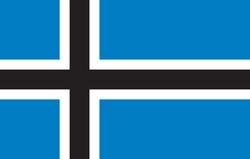Nordic identity in Estonia





A push towards being defined as a Nordic country has existed in independent Estonia since the first war of independence in 1918.[1][2] The first president of Estonia advocated for an Estonian-Finnish union in 1940. [3]
Estonia has shown continued interest in becoming a full member of the Nordic Council.
In 2005, Estonia joined the European Union's Nordic Battle Group. Estonia was invited to join NORDEFCO in 2011.[4]
There is an extensive economic interdependence between Estonia and its Nordic neighbours: three quarters of foreign investment in Estonia originates in the Nordic countries (principally Finland and Sweden), to which Estonia sends 42% of its exports (as compared to 6.5% going to Russia, 8.8% to Latvia, and 4.7% to Lithuania). An essay competition on the topic "Is Estonia Nordic?" was held in 2016, with 36 submitted essays by public activists and school students.[5] The essays of school students were predominantly acknowledging of Estonia's definition as a Nordic country. Essays of older citizens also contained criticism towards the idea.
Historical background
In the medieval period, the areas of Estonia and Latvia were considered to be a part of the "Northern countries".
Between 1400 and 1800, the coastal regions of Estonia and Latvia were part of the Hanseatic League, together with regions from South Sweden, Denmark, Northern Germany and Western Norway.
Modern political narrative
An important element in Estonia's post-independence reorientation has been closer ties with the Nordic countries, especially Finland and Sweden. In December 1999, then Estonian foreign minister (and President of Estonia from 2006 until 2016) Toomas Hendrik Ilves delivered a speech entitled "Estonia as a Nordic Country" to the Swedish Institute for International Affairs.[6] In 2003, the foreign ministry also hosted an exhibit called "Estonia: Nordic with a Twist".[7] In 1999, the foreign minister Toomas Hendrik Ilves's speech in the Swedish Foreign Policy Institute of "Estonia as a new Nordic country".[8]
In 2015, the Estonian prime minister Taavi Rõivas defined the country's narrative as a "New Nordic Country", or "Uus Põhjamaa".[9]
A conference comprising the heads of the coalition government was held in September 2016, discussing Estonia's outlook as a Nordic country.[10]
Becoming a new Nordic country does not necessarily mean that we will emulate the Nordic countries – copying will never make us anything else than a poor copy of Sweden. We have got to get to where we need to with more courage to take risks, we need to show more initiative, to experiment more and to also make more mistakes, not just limit ourselves to learning from others and continuing to compare ourselves against others. - Taavi Rõivas, Prime Minister of Estonia[11]
The current President of Estonia defines the Nordic and Baltic region as the "Nordic Benelux".[12]
The Nordic narrative is also communicated by government agencies:
- Invest in Estonia – The national investment agency[13]
- Nordica – the national airline
- RMK – the national forestry organization[14]
- Enterprise Estonia[15]
- The Foreign Ministry[7][16]
The cross flag has been used in the Estonian Parliament.[17][18]
Criticism
The movement towards defining Estonia as a Nordic country has also been criticized. The Tuglas foundation has claimed that the Nordic definition that Estonia is moving towards does not exist anymore, being a relic of past times.[19]
Quote from the organizer of an essay competition:
There are those who think we already are Nordic. There are those who think we have something to learn from the Nordic countries, adding to our own unique characteristics. And there are those who think that Estonia's location as a border country is unique and we should start focusing on it.[5]
Per Högselius wrote an opinion piece about the topic in 2003, looking at the idea as fringe, but concluding that "in time the Estonians might be able to persuade us".[20]
See also
References
- ↑ "Tiia Kõnnussaar: Eesti kui põhjamaa – elujõuline unistus | Eetikaveeb". Eetika.ee (in Estonian). 2016-08-22. Retrieved 2016-12-16.
- ↑ "Estonia Gravitates Towards Sweden: Nordic Identity and Activist Regionalism in World War I | Mart Kuldkepp". Academia.edu. 1970-01-01. Retrieved 2016-12-16.
- ↑
- ↑ Nordic military welcomes Baltic states on board
- 1 2 "Tiia Kõnnussaar: Eesti kui põhjamaa – elujõuline unistus". Arvamus.postimees.ee. Retrieved 2016-12-16.
- ↑ Ilves, Toomas Hendrik (14 December 1999). "Estonia as a Nordic Country". Estonian Foreign Ministry. Retrieved 19 September 2009.
- 1 2 "Estonia – Nordic with a Twist". Archived from the original on 8 February 2008.
- ↑ "Välisminister Ilvese loeng Rootsi Välispoliitika Instituudis: "Eesti kui Põhjamaa" (inglise keeles) | Välisministeerium". Vm.ee (in Estonian). 1999-12-14. Retrieved 2016-12-16.
- ↑ "Taavi Rõivas: Eesti suur narratiiv on Uus Põhjamaa | Reformierakond". Reform.ee. Retrieved 2016-12-16.
- ↑ ""Estonia AND the Nordic countries – Estonia AS a Nordic country?" conference summary and videos". Norden.ee. Retrieved 2016-12-16.
- ↑
- ↑ "LSM / Kersti Kaljulaid: Let's talk about the Nordic Benelux / Eng.lsm.lv". Lsm.lv. 2016-10-25. Retrieved 2016-12-16.
- ↑ "Estonia - Nordic With A Twist". Invest in Estonia. 2015-09-15. Retrieved 2016-12-16.
- ↑ "RMK has the most visited forestry-related homepage | RMK". Rmk.ee. Retrieved 2016-12-16.
- ↑ "EAS - Ettevõtluse Arendamise Sihtasutus". Eas.ee. Retrieved 2016-12-16.
- ↑ "Estonia as a Nordic Country | Välisministeerium". Vm.ee (in Estonian). 1999-12-14. Retrieved 2016-12-16.
- ↑ Tsahkna laulis riigikogus Savisaarest ja Parbusest
- ↑ Reporter.ee: Riisalu kritiseeris jõuluvana stiili
- ↑ "Tuglas-seura | Kas Eesti on Põhjamaa?". Tuglas.fi. Retrieved 2016-12-16.
- ↑ "Estland längtar så in i Norden | Per Högselius | SvD". Svd.se. 2003-11-20. Retrieved 2016-12-16.
